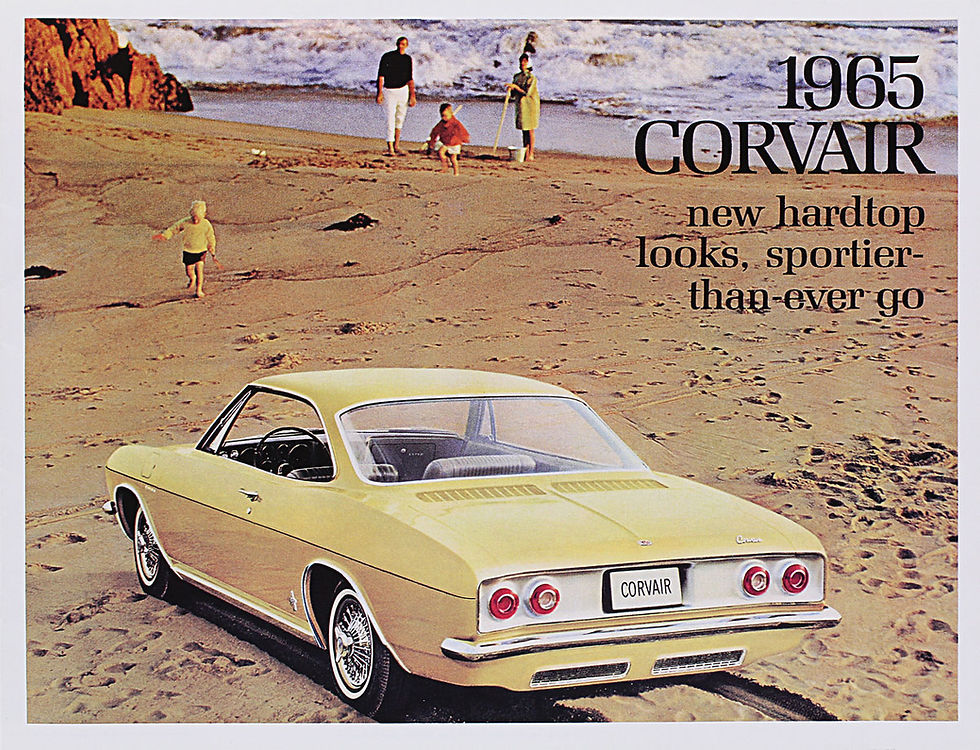The Corvair second generation arrived for the model year 1965, noted for its lack of a "B" pillar and a new fully independent suspension replacing the original swing axle rear suspension. The Corvair used coil springs at each wheel.
Car and Driver magazine's David E. Davis Jr. showed enthusiasm for the 1965 Corvair in their October 1964 issue:
"And it is here too, that we have to go on record and say that the Corvair is in our opinion—the most important new car of the entire crop of '65 models, and the most beautiful car to appear in this country since before World War II." "When the pictures of the '65 Corvair arrived in our offices, the man who opened the envelope actually let out a great shout of delight and amazement on first seeing the car, and in thirty seconds the whole staff was charging around, each wanting to be the first to show somebody else, each wanting the vicarious kick of hearing that characteristic war-whoop from the first-time viewer." "Our ardor had cooled a little by the time we got to drive the cars—then we went nuts all over again. The new rear suspension, the new softer spring rates in front, the bigger brakes, the addition of some more power, all these factors had us driving around like idiots—zooming around the handling loop dragging with each other, standing on the brakes—until we had to reluctantly turn the car over to some other impatient journalist ... The '65 Corvair is an outstanding car. It doesn't go fast enough, but we love it."

The standard 95 hp (71 kW; 96 PS) and optional 110 hp (82 kW; 112 PS) engines were carried forward from 1964. The previous 150 hp (112 kW; 152 PS) Spyder engine was replaced by the normally aspirated 140 hp (104 kW; 142 PS) for the new Corsa. The engine was unusual in offering four single-throat carburetors, to which were added larger valves and a dual exhaust system. A 180 hp (134 kW; 182 PS) turbocharged engine was optional on the Corsa, which offered either standard three-speed or optional (US$92) four-speed manual transmissions. The 140 hp (104 kW; 142 PS) engine was optional on 500 and Monza models with manual or Powerglide transmissions. All engines got some of the heavy-duty internal parts from the Turbocharged engine for better durability.

New refinements appeared on the 1965 redesign. The Corsa came standard with an instrument panel featuring a 140 mph (230 km/h) speedometer with resettable trip odometer, a 6,000 rpm tachometer, cylinder head temperature gauge, analog clock with a sweeping second hand, a manifold vacuum/pressure gauge, and fuel gauge. A much better heater system, larger brakes borrowed from the Chevelle, a stronger differential ring gear, a Delcotron alternator (replacing the generator), and significant chassis refinements were made. Out back, a new fully articulated rear suspension virtually eliminated the danger of the previous generation's swing axles and was based on the contemporary Corvette Sting Ray (Corvair used coil springs while the Sting Ray uses a transverse leaf). AM/FM stereo radio, in-dash All Weather Air Conditioning, telescopically adjustable steering column, and a Special Purpose Chassis Equipment ("Z17") handling package, consisting of a special performance suspension and quick ratio steering box, were significant new options for 1965. The Monza and Corvair 500 Sport Sedans were the only compact cars ever available in the U.S. as pillarless four-door hardtops.
Source: Wikipedia

























